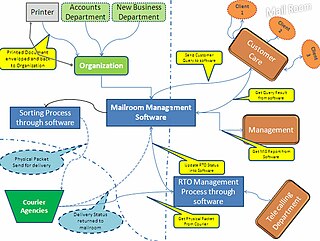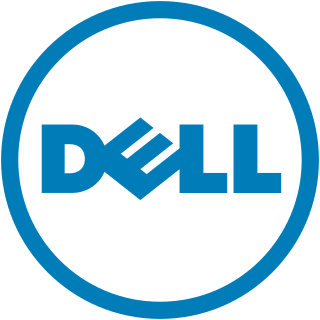
The Gramm–Leach–Bliley Act (GLBA), also known as the Financial Services Modernization Act of 1999, is an act of the 106th United States Congress (1999–2001). It repealed part of the Glass–Steagall Act of 1933, removing barriers in the market among banking companies, securities companies, and insurance companies that prohibited any one institution from acting as any combination of an investment bank, a commercial bank, and an insurance company. With the passage of the Gramm–Leach–Bliley Act, commercial banks, investment banks, securities firms, and insurance companies were allowed to consolidate. Furthermore, it failed to give to the SEC or any other financial regulatory agency the authority to regulate large investment bank holding companies. The legislation was signed into law by President Bill Clinton.
Enterprise content management (ECM) extends the concept of content management by adding a timeline for each content item and, possibly, enforcing processes for its creation, approval, and distribution. Systems using ECM generally provide a secure repository for managed items, analog or digital. They also include one methods for importing content to bring manage new items, and several presentation methods to make items available for use. Although ECM content may be protected by digital rights management (DRM), it is not required. ECM is distinguished from general content management by its cognizance of the processes and procedures of the enterprise for which it is created.
Software as a service is a software licensing and delivery model in which software is licensed on a subscription basis and is centrally hosted. SaaS is also known as on-demand software, web-based software, or web-hosted software.
Shadow system is a term used in information services for any application relied upon for business processes that is not under the jurisdiction of a centralized information systems department. That is, the information systems department did not create it, was not aware of it, and does not support it.
Software asset management (SAM) is a business practice that involves managing and optimizing the purchase, deployment, maintenance, utilization, and disposal of software applications within an organization. According to ITIL, SAM is defined as “…all of the infrastructure and processes necessary for the effective management, control, and protection of the software assets…throughout all stages of their lifecycle.” Fundamentally intended to be part of an organization's information technology business strategy, the goals of SAM are to reduce information technology (IT) costs and limit business and legal risk related to the ownership and use of software, while maximizing IT responsiveness and end-user productivity. SAM is particularly important for large corporations regarding redistribution of licenses and managing legal risks associated with software ownership and expiration. SAM technologies track license expiration, thus allowing the company to function ethically and within software compliance regulations. This can be important for both eliminating legal costs associated with license agreement violations and as part of a company's reputation management strategy. Both are important forms of risk management and are critical for large corporations' long-term business strategies.
Expense management refers to the systems deployed by a business to process, pay, and audit employee-initiated expenses. These costs include, but are not limited to, expenses incurred for travel and entertainment. Expense management includes the policies and procedures that govern such spending, as well as the technologies and services utilized to process and analyze the data associated with it.

On-premises software is installed and runs on computers on the premises of the person or organization using the software, rather than at a remote facility such as a server farm or cloud. On-premises software is sometimes referred to as "shrinkwrap" software, and off-premises software is commonly called "software as a service" ("SaaS") or "cloud computing".
Mobile device management (MDM) is the administration of mobile devices, such as smartphones, tablet computers, and laptops. MDM is usually implemented with the use of a third-party product that has management features for particular vendors of mobile devices. Though closely related to Enterprise Mobility Management and Unified Endpoint Management, MDM differs slightly from both: unlike MDM, EMM includes mobile information management, BYOD, mobile application management and mobile content management, whereas UEM provides device management for endpoints like desktops, printers, IoT devices, and wearables as well.

Accounting software is a computer program that maintains account books on computers, including recording transactions and account balances. It may depends on virtual thinking. Depending on the purpose, the software can manage budgets, perform accounting tasks for multiple currencies, perform payroll and customer relationship management, and prepare financial reporting. Work to have accounting functions be implemented on computers goes back to the earliest days of electronic data processing. Over time, accounting software has revolutionized from supporting basic accounting operations to performing real-time accounting and supporting financial processing and reporting. Cloud accounting software was first introduced in 2011, and it allowed the performance of all accounting functions through the internet.
Email archiving is the act of preserving and making searchable all email to/from an individual. Email archiving solutions capture email content either directly from the email application itself or during transport. The messages are typically then stored on magnetic disk storage and indexed to simplify future searches. In addition to simply accumulating email messages, these applications index and provide quick, searchable access to archived messages independent of the users of the system using a couple of different technical methods of implementation. The reasons a company may opt to implement an email archiving solution include protection of mission critical data, to meet retention and supervision requirements of applicable regulations, and for e-discovery purposes. It is predicted that the email archiving market will grow from nearly $2.1 billion in 2009 to over $5.1 billion in 2013.
Enterprise mobility management (EMM) is the set of people, processes and technology focused on managing mobile devices, wireless networks, and other mobile computing services in a business context. As more workers have bought smartphone and tablet computing devices and have sought support for using these devices in the workplace, EMM has become increasingly significant.
Information governance, or IG, is the overall strategy for information at an organization. Information governance balances the risk that information presents with the value that information provides. Information governance helps with legal compliance, operational transparency, and reducing expenditures associated with legal discovery. An organization can establish a consistent and logical framework for employees to handle data through their information governance policies and procedures. These policies guide proper behavior regarding how organizations and their employees handle information whether it is physically or electronically created (ESI).

Digital mailroom is the automation of incoming mail processes. Using document scanning and document capture technologies, companies can digitise incoming mail and automate the classification and distribution of mail within the organization. Both paper and electronic mail (email) can be managed through the same process allowing companies to standardize their internal mail distribution procedures and adhere to company compliance policies.
Hewlett Packard Enterprise Networking is the Networking Products division of Hewlett Packard Enterprise. HPE Networking and its predecessor entities have developed and sold networking products since 1979. Currently, it offers networking and switching products for small and medium sized businesses through its wholly owned subsidiary Aruba Networks. Prior to 2015, the entity within HP which offered networking products was called HP Networking.
Mobile application management (MAM) describes the software and services responsible for provisioning and controlling access to internally developed and commercially available mobile apps used in business settings, on both company-provided and 'bring your own' mobile operating systems as used on smartphones and tablet computers.
Bring your own device —also called bring your own technology (BYOT), bring your own phone (BYOP), and bring your own personal computer (BYOPC)—refers to being allowed to use one's personally owned device, rather than being required to use an officially provided device.

Dell Software was a former division of Dell with headquarters in Round Rock, Texas, United States. Dell Software was created by merging various acquisitions by Dell Inc., the third-largest maker of PCs and now a privately held company, to build out its software offerings for data center and cloud management, information management, mobile workforce management, security and data protection for organizations of all sizes.
A mobile workspace is a user's portable working environment that gives them access to the applications, files and services they need to do their job no matter where they are.
Enterprise legal management (ELM) is a practice management strategy of corporate legal departments, insurance claims departments, and government legal and contract management departments.

IBM MaaS360 is a SaaS Unified Endpoint Management (UEM) solution offered by IBM that manages and protects any existing endpoint including laptops, desktops, mobile devices and apps, wearables, IoT and purpose built devices and allow protected, low risk access to company resources. IBM Security MaaS360 with Watson integrates with current security platforms owned by different companies. It’s AI powered analytics removes friction by reducing actions required from the device user.





